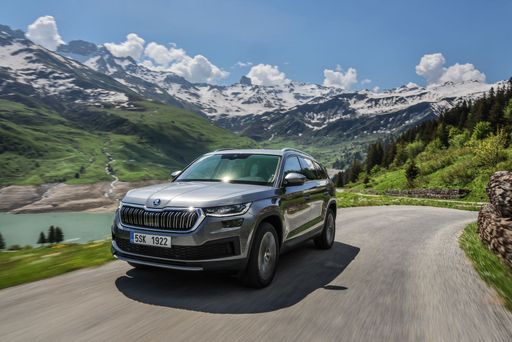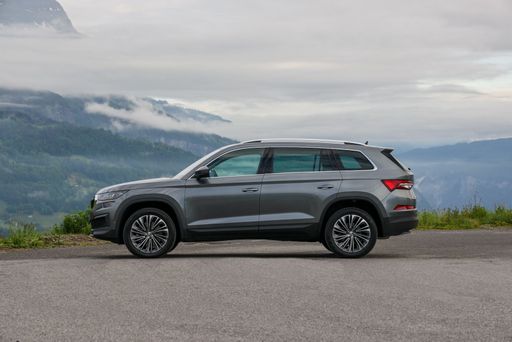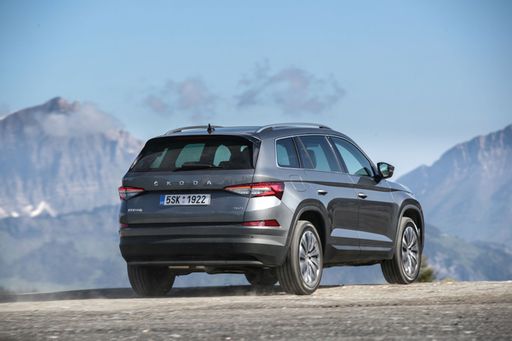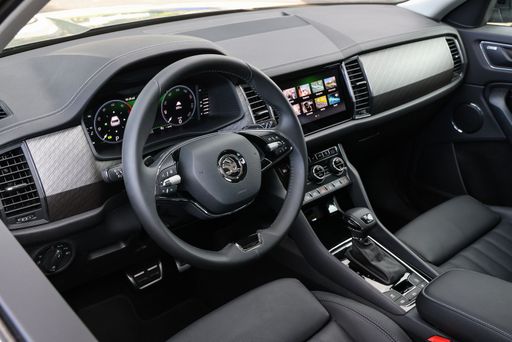Skoda Kodiaq vs Hyundai IONIQ 9 – Which car suits you better?
Compare performance, boot capacity, efficiency and price at a glance.
Find out which car is the better choice for you – Skoda Kodiaq or Hyundai IONIQ 9?
Here’s where it gets real: The technical differences in detail
Costs and Efficiency: Price and efficiency are often the first things buyers look at. Here it becomes clear which model has the long-term edge – whether at the pump, the plug, or in purchase price.
Skoda Kodiaq has a clearly advantage in terms of price – it starts at 36800 £, while the Hyundai IONIQ 9 costs 58700 £. That’s a price difference of around 21866 £.
As for range, the Hyundai IONIQ 9 performs decisively better – achieving up to 620 km, about 497 km more than the Skoda Kodiaq.
Engine and Performance: Power, torque and acceleration are the classic benchmarks for car enthusiasts – and here, some clear differences start to show.
When it comes to engine power, the Hyundai IONIQ 9 has a clearly perceptible edge – offering 428 HP compared to 265 HP. That’s roughly 163 HP more horsepower.
In acceleration from 0 to 100 km/h, the Hyundai IONIQ 9 is distinct quicker – completing the sprint in 5.20 s, while the Skoda Kodiaq takes 6.30 s. That’s about 1.10 s faster.
In terms of top speed, the Skoda Kodiaq performs somewhat better – reaching 231 km/h, while the Hyundai IONIQ 9 tops out at 200 km/h. The difference is around 31 km/h.
There’s also a difference in torque: the Hyundai IONIQ 9 pulls significantly stronger with 700 Nm compared to 400 Nm. That’s about 300 Nm difference.
Space and Everyday Use: Beyond pure performance, interior space and usability matter most in daily life. This is where you see which car is more practical and versatile.
Seats: Hyundai IONIQ 9 offers evident more seating capacity – 7 vs 5.
In curb weight, the Skoda Kodiaq is clearly lighter – 1684 kg compared to 2594 kg. The difference is around 910 kg.
In terms of boot space, the Skoda Kodiaq offers decisively more room – 910 L compared to 338 L. That’s a difference of about 572 L.
In maximum load capacity, the Hyundai IONIQ 9 performs to a small extent better – up to 2419 L, which is about 314 L more than the Skoda Kodiaq.
When it comes to payload, Hyundai IONIQ 9 to a small extent takes the win – 643 kg compared to 545 kg. That’s a difference of about 98 kg.
Our conclusion: The Hyundai IONIQ 9 proves to be dominates this comparison and thus becomes our DriveDuel Champion!
Overall, Hyundai IONIQ 9 is the better all-rounder in this comparison.
Skoda Kodiaq
The Škoda Kodiaq impresses with its spacious interior and sleek design, making it a popular choice for families and adventurers alike. Equipped with a range of modern features, it offers a comfortable driving experience and outstanding versatility. Its robust build and refined handling make it suitable for both urban settings and countryside escapades.
details @ skoda-media.de
@ skoda-media.de
 @ skoda-media.de
@ skoda-media.de
 @ skoda-media.de
@ skoda-media.de
 @ skoda-media.de
@ skoda-media.de
 @ skoda-media.de
@ skoda-media.de
Hyundai IONIQ 9
The Hyundai IONIQ 9 is a bold step forward in the automotive world, combining cutting-edge electric technology with a sleek and modern design. This model stands out with its spacious interior and advanced features, ensuring both comfort and convenience for drivers and passengers alike. As Hyundai pushes the envelope in eco-friendly innovation, the IONIQ 9 represents the future of sustainable driving with its impressive range and performance capabilities.
details

|
|
|
|
|
Costs and Consumption |
|
|---|---|
|
Price
36800 - 49600 £
|
Price
58700 - 74400 £
|
|
Consumption L/100km
0.4 - 8.2 L
|
Consumption L/100km
-
|
|
Consumption kWh/100km
-
|
Consumption kWh/100km
19.9 - 20.6 kWh
|
|
Electric Range
113 - 123 km
|
Electric Range
600 - 620 km
|
|
Battery Capacity
19.70 kWh
|
Battery Capacity
110 kWh
|
|
co2
9 - 186 g/km
|
co2
0 g/km
|
|
Fuel tank capacity
45 - 58 L
|
Fuel tank capacity
-
|
Dimensions and Body |
|
|---|---|
|
Body Type
SUV
|
Body Type
SUV
|
|
Seats
5
|
Seats
7
|
|
Doors
5
|
Doors
5
|
|
Curb weight
1684 - 1970 kg
|
Curb weight
2594 - 2689 kg
|
|
Trunk capacity
745 - 910 L
|
Trunk capacity
338 L
|
|
Length
4758 - 4761 mm
|
Length
5060 mm
|
|
Width
1864 mm
|
Width
1980 mm
|
|
Height
1663 - 1683 mm
|
Height
1790 mm
|
|
Max trunk capacity
1945 - 2105 L
|
Max trunk capacity
2419 L
|
|
Payload
460 - 545 kg
|
Payload
586 - 643 kg
|
Engine and Performance |
|
|---|---|
|
Engine Type
Plugin Hybrid, Petrol, Petrol MHEV, Diesel
|
Engine Type
Electric
|
|
Transmission
Automatic
|
Transmission
Automatic
|
|
Transmission Detail
Dual-Clutch Automatic
|
Transmission Detail
Reduction Gearbox
|
|
Drive Type
Front-Wheel Drive, All-Wheel Drive
|
Drive Type
Rear-Wheel Drive, All-Wheel Drive
|
|
Power HP
150 - 265 HP
|
Power HP
218 - 428 HP
|
|
Acceleration 0-100km/h
6.3 - 9.7 s
|
Acceleration 0-100km/h
5.2 - 9.4 s
|
|
Max Speed
205 - 231 km/h
|
Max Speed
190 - 200 km/h
|
|
Torque
250 - 400 Nm
|
Torque
350 - 700 Nm
|
|
Number of Cylinders
4
|
Number of Cylinders
-
|
|
Power kW
110 - 195 kW
|
Power kW
160 - 315 kW
|
|
Engine capacity
1498 - 1984 cm3
|
Engine capacity
-
|
General |
|
|---|---|
|
Model Year
2024 - 2025
|
Model Year
2025
|
|
CO2 Efficiency Class
B, F, G, E
|
CO2 Efficiency Class
A
|
|
Brand
Skoda
|
Brand
Hyundai
|
What drive types are available for the Skoda Kodiaq?
The Skoda Kodiaq is available as Front-Wheel Drive or All-Wheel Drive.
The prices and data displayed are estimates based on German list prices and may vary by country. This information is not legally binding.
